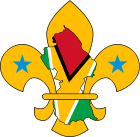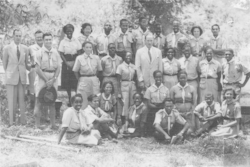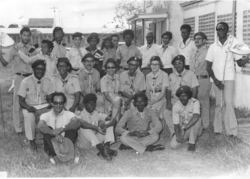The Scout Association of Guyana
The Scout Association of Guyana had its origin as a branch of The Boy Scouts Association of the United Kingdom in 1909 and joined the World Organization of the Scout Movement in 1967. In 2008, it was reported that the association had 424 members.[1]
| The Scout Association of Guyana | |||
|---|---|---|---|
 | |||
| Headquarters | Woolford Avenue, Thomas Lands, Georgetown | ||
| Location | Woolford Avenue, Thomas Lands, Georgetown | ||
| Country | Guyana | ||
| Chief Scout | Ramsay Alli | ||
|
| |||
| Website Archived October 3, 2008, at the Wayback Machine | |||
History
Some of the early Scout Troops in British Guiana registered with The Boy Scouts Association of the United Kingdom which established a branch in British Guiana. The Boy Scouts Association appointed a District Commissioner, District Committee and its Executive Committee. In 1920 these became the Colony Commissioner, Colony Boy Scout Council and its Executive Committee. The British Guiana branch of The Boy Scouts Association changed its name to The Scout Association of Guyana. The Scout Association of Guyana joined the World Organization of the Scout Movement in 1967.
In the 1960s, Scouting in Guyana was able to boast of Land, Sea and Air Scouts and Rovers. Sea and Air Scouts no longer exist. Scouting in Guyana was probably at its peak around 1969 when their Diamond Jubilee was celebrated and the 3rd Caribbean Jamboree was held there in August. In 1974 the government formed the Guyana National Service, a compulsory youth organization. This affected the organization's numbers. Some leaders joined the National Service where they were paid. While there was no ban on Scouting during this period, the organization was obliged to keep a low profile. With changes in the political situation came renewed support for Scouting in the 1980s.
Early troops
In 1909, a Scout Troop was formed at Queen's College in what was then British Guiana. This Troop was under the leadership of George Manly, a Sergeant Major in the British Regiment stationed there.
The Scout Movement spread rapidly in British Guiana with Troops being attached chiefly to church schools. There were few open Troops in the beginning, but one which flourished was Troop 39. It was the first Troop to make the overland journey to Kaieteur Falls. This Troop produced some of Guyana's scout leaders - including two Chief Commissioners, D.B. St. Aubyn and Lawrence Thompson, and 4 Assistant Chief Commissioners for Cubs.

Scouting spread from the county of Demerara to the county of Berbice, where a renowned Troop, Lady Davson's Own, was formed.
Scouting emerged in the county of Essequibo in the 1940s with Troops mostly attached to Church Schools. A troop was started at Onderneeming Boys' Reformatory in Suddie. Sam Cummings, an instructor at the School, was the first Scout Leader, followed by the Headmaster, a Mr Kissoon. There were a few Troops and Packs in the Pomeroon and Rupununi districts. For many of these Troops the departure of the resident Priest meant closure of the Troop. A Troop at Kamarang, Upper Mazaruni, catering mainly for Amerindian boys, was run by Canon John Dorman, who had been trained as a scout leader at Gilwell, England.
Another prominent Troop was St Stanislaus College Troop, catering for Roman Catholic boys before the school became co-educational. Among its leaders was Father Bernard Darke, S.J., who had been trained as a Scout Leader at Gilwell, England and made a great contribution to Scouting in Guyana before his death. As well as running the Troop he served on Guyana's Scout Executive Committee and was a member of the Leader Training Team.
Training
To obtain the highest rank in Guyana, a Scout must pass the normal proficiency tests, and, in addition, must be able to obtain badges in agriculture, which prepares each Scout to feed himself from his own produce.
Leader training

Many of the Anglican and Roman Catholic priests who came from England to serve in Guyana had received Scout Leader Wood Badge training at The Boy Scouts Association's Gilwell Park in England. These included the late Archbishop of the West Indies, Dr Alan John Knight, who served on the Colony Scout Council for many years and welcomed the Cub Pack from St Gabriel's School, Convent of the Good Shepherd, who held their meetings on the lawn of his residence, Austin House, for many years. A lack of official trainers in Guyana had Scouters train at Paxdale, Trinidad for many years. Brian Fox, seconded from England in the 1950s spent about three years training leaders and expanding Scouting. It was in this time that British Guiana's Scout Training Team was formed.
Presidents
Presidents of the organization have included:
- Justice E. Hewick (1910)
- Hon Geo. Garnett, CMG (1911)
- Sir Alfred P Sherlock (1913)
- Colonel WE Clarke (1918)
- Colonel Cecil May (1919)
- Colonel FH Blackwood, DSO (1925)
- Hon Hector Josephs, KC (1926)
- Admiral FC Fisher (1929)
- Rev Canon JT Robert, REA (1930)
- Prof J Sydney Dash (1937)
- LG Crease (1942)
- Capt H Nobbs, OBE (1950)
Commissioners
Early Commissioners were referred to as District Commissioners. In 1920 their title was changed to Colony Commissioner. Commissioners have included:
- Capt LD Cleare (1913)
- HW Sconce (1919)
- Major William Bain-Gray (Director of Education) (1925)
- Rev C Norman (1926)
- Hon C Douglas-Jones, CMG (Colonial Secretary) (1929)
- Capt R Patrick (Director of Education Acting) (1929)
- Capt F Burnett (1930)
- JD Gillespie (1931)
- Fred T Weston (1941)
- John R Durey, MBE (Awarded Silver Acorn) (1942)
- DB St Aubyn, MBE (1952)
Cub Scouts
Cubbing in Guyana started in 1926, the first pack being St Barnabas Anglican Church, under the leadership of Mr Braithwaite. The first ACC Cubs was Mrs Isadora Walton, Cubmaster of Pack 39, who did a great deal to spread this section of the organization.
The first Guyanese Cubmaster to be trained at Gilwell was Evelyn St Aubyn who succeeded Isadora Walton as ACC Cubs around 1938. George Manly's granddaughter, Daphne Manly, ran Pack 39 for many years.
40th Anniversary of Cubbing
A special program of activities was planned for the 40th Anniversary of Cubbing in Guyana. On 17 April 1966 over 200 Cubs spent the day at Camp Jubilee observing Cub Day. Clement Gomes and the Camp Jubilee staff assisted Pack Scouters. Communion services were held on arrival in both Anglican and Roman Catholic chapels, and were well attended.
On 20 August Packs held a campfire at Scout Headquarters to raise funds for the Blind Association. Michael Pereira arranged the program. The campfire was well attended and raised $108.50.
On 2 October a party of Old Wolves spent the day at Camp Jubilee. Three yellow cassia trees were planted by CC Lewis, E. Reece and Elsie Taylor in commemoration of the 40th Anniversary. On 30 October Thanksgiving services were held at Main Street Catholic Church and Christ Church (Anglican).
On 26 November the Annual Play Acting Competition was held at Scout Headquarters. The Cup, presented by its donor, Mr. LB Thompson, was won by St Francis Pack. On 9 December Old Wolves entertained Mr. George Mitchell in the Cub Den. Mr. Mitchell expressed his pleasure at seeing the Den, whose sod he had turned on his previous visit in 1963.
Census
- 1987: 341 Scouts, 125 Cubs and 49 Leaders
- 2001: 399 members
- 2008: 424 members [1]
See also
References
- "Triennial Report 2005-2008" (PDF). World Organization of the Scout Movement. Archived from the original (PDF) on 2008-09-09. Retrieved 2008-07-13.